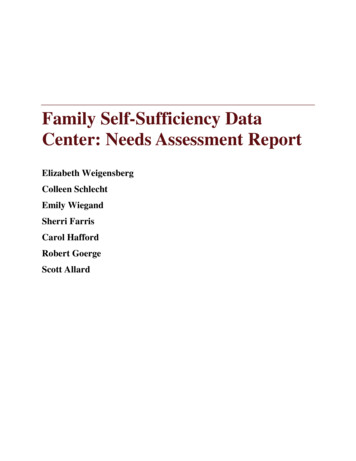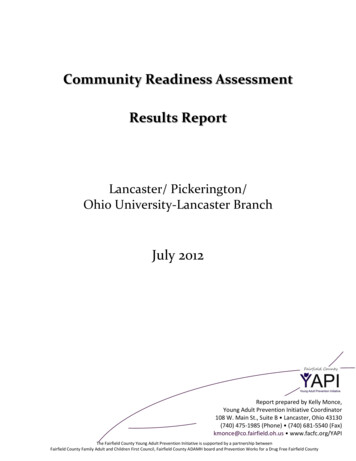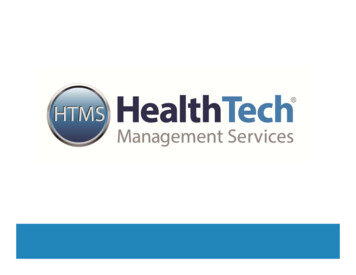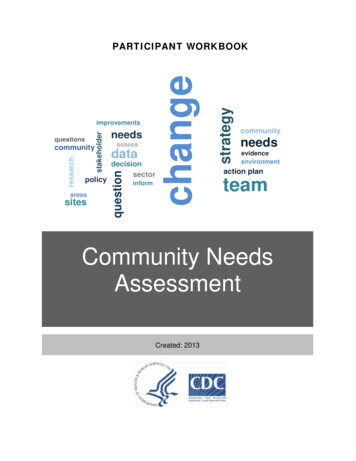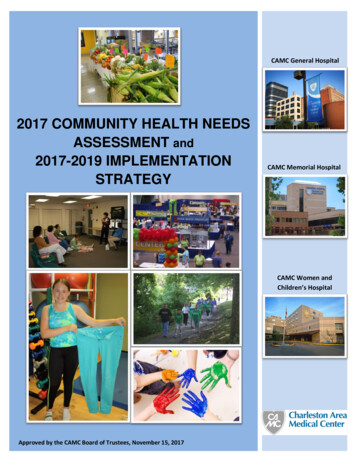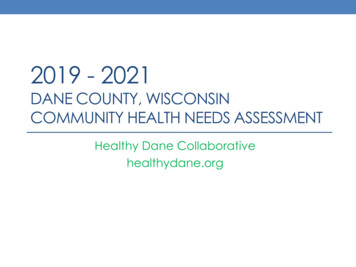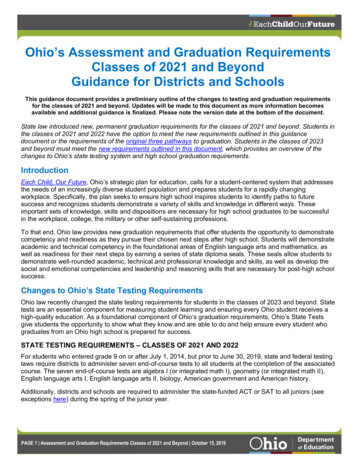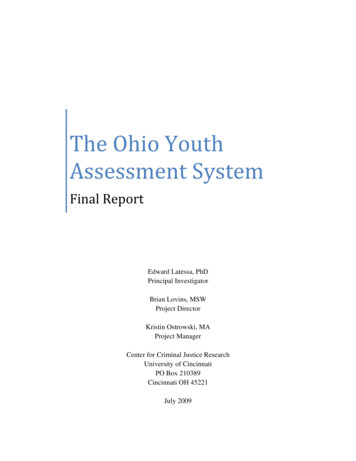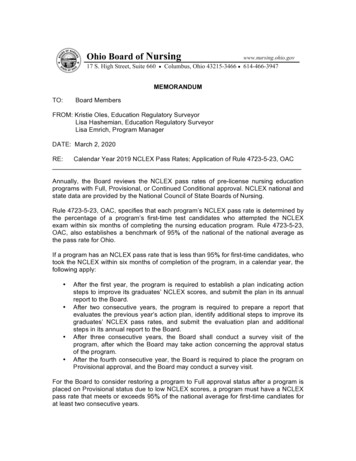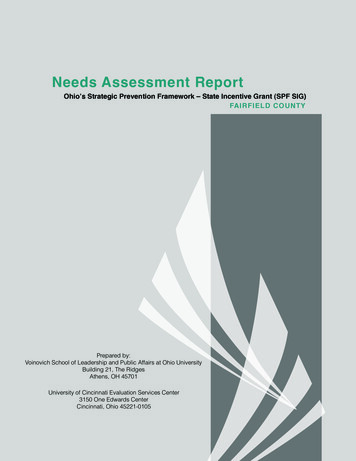
Transcription
Needs Assessment ReportOhio’s Strategic Prevention Framework – State Incentive Grant (SPF SIG)FAIRFIELD COUNTYPrepared by:Voinovich School of Leadership and Public Affairs at Ohio UniversityBuilding 21, The RidgesAthens, OH 45701University of Cincinnati Evaluation Services Center3150 One Edwards CenterCincinnati, Ohio 45221-0105
Table of ContentsCommunity Profile . 1Introduction . 2Recent Community Needs Assessments . 4Community Readiness . 6Individual-Level . 8Interpersonal-Level . 12Community-Level . 15Retail Factors. 15Social Availability Factors . 18Promotional Factors. 21Organizational-Level . 24Capacities . 24Gaps . 25Policy-Level . 26Cultural Competence . 29Millennials (Generation Next). 29Sub-Target/Underserved Population . 31Generation Rx . 32Appendix I: Organizational-Level Assessment Tools. 33Appendix II: Additional Policy Information . 51Appendix III: Fairfield Medical Center Emergency Department Guidelines . 52
Community ProfileFairfield County has an estimated population of 147,066. The population is predominantly Caucasian(90.4%), with a small African American population (6.2%). Approximately 1.9% of the populationidentifies as multiracial and a similar percentage (1.9%) of the county’s population reports being ofHispanic or Latino origin.English is the predominant language, with 3.9% of residents reporting that another language is spokenat home.Among residents above 25 years of age, 91.6% have a high school diploma and 24.4% have a Bachelor’sdegree or higher. The high school graduation rate in the county is considerably higher than that in thestate (87.4%) whereas the percentage of higher education degrees in the county is similar to the staterate (24.1%).The median household income (2006-2010) is 56,796, which is above the state median of 47,358.The five year (2006-2010) estimated percentage of the county population below poverty level is 10.4%.This is considerably better than the estimated state percentage (14.2%).Fairfield County is home to a satellite campus of Ohio University.Note: Data sources include the 2011 Census and the 2006-2010 American Community Survey.Fairfield CountySPF SIG Needs Assessment Report1
IntroductionThe community’s biggest issue related to substance abuse:The prescription opiate problem, and the community perception of that problem, has caused greatconcern in Fairfield County. Data collected from our 18-25 year-old individual consumption andperception survey indicates that prescription opiate misuse is indeed a large issue; 25.2% of 18-25 yearolds in Lancaster reported lifetime misuse of prescription pain medication. Prevalence of misuse ofprescription pain medication is also evident in Pickerington (18.2% reporting lifetime misuse) and on theOhio University Lancaster Campus and Pickerington Center (15.0% reporting lifetime misuse). However,data from the same survey also indicates that misuse of prescription medication in general is also aconcern; with 32.6% (Lancaster), 35.2% (Pickerington), and 23.2% (Ohio University L/P campuses) of 1825 year olds reporting lifetime use of a prescription drug without a doctor’s prescription.** Fairfield County, Ohio Young Adult Survey - 2012A description of the population being targeted for SPF SIG project:Our target population includes all young adults (18-25 years of age) living in Lancaster, Ohio. Lancasterrepresents the largest population of 18-25 year olds in Fairfield County. Lancaster is home to 3,929 1825 year olds which is 10.13% of the city’s population. Lancaster 18-25 year-old consumption andperception data* shows that, when asked, “How old were you the first time you used a prescriptionmedication that was not prescribed for you?” The maximum age of first use was 23 years old; with14.7% reporting first use between the ages of 18-23 and 58.3% reported never having used. This datashows that there is a continued need for primary prevention once persons hit the 18-25 year-old agerange. Through the needs assessment process our coalition has determined that while some effortshave been made, Lancaster does not yet have a comprehensive prevention strategy for 18-25 year oldsin our community. Results from our Community Readiness Assessment*** show that Lancaster is at aStage 4- Preplanning and is primed and ready for prevention efforts.* Fairfield County, Ohio Young Adult Survey – 2012*** Fairfield County Community Readiness Assessment-2012Sub-target/underserved population(s) chosen for SPF SIG project: Ohio University - Lancaster/Pickerington Campus Pickerington 18-25 year oldsFairfield CountySPF SIG Needs Assessment Report2
Description of sub-target/underserved population(s):Ohio University- Lancaster/Pickerington Campus: Sub-population A for this project is all young adults(18-25 years old) attending Ohio University Lancaster and Ohio University Pickerington campuses (1,486students). Ohio University 18-25 year-old consumption and perception data *shows that, when asked,“How old were you the first time you used a prescription medication that was not prescribed for you?”8.94% reported first use between the ages of 18-25 and 71.2% reported never having used. This datashows a continued need for primary prevention once persons hit the 18-25 year-old age range. This subtarget population was selected for multiple reasons. The first is due to a specific request from thecampus, additionally through the needs assessment process our coalition has determined that whilesome efforts have been made, Lancaster does not yet have a comprehensive prevention strategy for 1825 year olds in our community. Results from our Community Readiness Assessment*** show that thiscommunity is at a Stage 2-Denial/Resistance.* Fairfield County, Ohio Young Adult Survey – 2012*** Fairfield County Community Readiness Assessment-2012Pickerington 18-25 year olds: Sub-population B for this project is all young adults (18-25 years old) livingin the city of Pickerington (1,392 18-25 year olds) which is 7.61% of the city’s population. Pickerington18-25 year-old consumption and perception data* shows that, when asked, “How old were you the firsttime you used a prescription medication that was not prescribed for you?” The maximum age of first usewas 24 years old; with 14.9% reporting first use between the ages of 18-24 and 56.9% reported neverhaving used. This data shows a continued need for primary prevention once persons hit the 18-25 yearold age range. Through the needs assessment process our coalition has determined that while someefforts have been made, Pickerington does not yet have a comprehensive prevention strategy for 18-25year olds in our community. Results from our Community Readiness Assessment*** show thatPickerington is at a Stage 3-Vague Awareness.* Fairfield County, Ohio Young Adult Survey – 2012*** Fairfield County Community Readiness Assessment-2012Fairfield CountySPF SIG Needs Assessment Report3
Recent Community Needs AssessmentsTotal Number of Needs Assessments: ThreeNeeds Assessment:Year Conducted:Sponsoring AgencyFindings Relevant to18-25 Year Olds:Fairfield First2007United WayNone Findings Relevant toCommunity Readiness:Needs Assessment:Year Conducted:Sponsoring AgencyFindings Relevant to18-25 Year Olds:Findings Relevant toCommunity Readiness:Pg. 6 - Mental health and addiction issues were viewed aspredominate in household and key informant surveys and thesecondary research. Many respondents voiced the need for expandedservices.Pg. 16 - In the household phone survey, “alcoholism or drug abuse”ranked as the second highest area of concern at 27%.Pg. 23 - In Phase II the visioning committee listed the following asissues:o Community recognizes addiction and mental health as seriousproblems but many perceive these issues as “moral flaws” andhave difficulty supporting it financially.o Growing demand for opiate related detox centers.o Heroin is increasing, and overprescribing pharmaceuticalswith opiates (access increasing).o Perceived safety due to rural nature of the county. “We don’thave the problems of big cities.”Fairfield County Health Assessment2010Fairfield County Department of Health, Fairfield Medical Center, FairfieldCommunity Health 5% of all Fairfield County adults used recreational drugs in the past sixmonths, 7% of adults under the age of 30 were current users and 10%of adults with incomes 25,000 were current users. 5% of adults had used medication not prescribed to them or they tookmore than prescribed to feel good or high and/or more active andalert during the past 6 months. 6% of adults had taken prescription opiates (Oxycontin, Codeine,Demerol, etc.) on a regular basis for more than two weeks.NoneFairfield CountySPF SIG Needs Assessment Report4
Needs Assessment:Year Conducted:Sponsoring AgencyFindings Relevant to18-25 Year Olds:Findings Relevant toCommunity Readiness:Fairfield County Youth Behavior Survey2004, 2006, 2008, 2010, 2012Prevention Works for a Drug Free Fairfield County, Fairfield County FamilyAdult and Children First Council High school seniors: 30 day use of other peoples’ prescription drugs 9.3% (2004), 8.5% (2006), 7.2% (2008), 5.7% (2010), 2.4% (2012) High school seniors: Average age of first use of illegal Rx drugs - 14.85(2004), 14.59 (2006), 15.60 (2008), 14.84 (2010), 15.08 (2012) High school seniors: Ease of access of illegal Rx drugs (“very easy” and“somewhat easy”) - 49% (2004), 49% (2006), 45.3% (2008), 45.7%(2010), 35.7% (2012) High school seniors: Perception of harm of other peoples’ Rx drugs 2.3 (2004), 2.34 (2006), 2.46 (2008), 2.48 (2010) (on a scale of 1-3 with1 being the lowest harm), 61.6% (2012) (“great risk”) High school seniors (2012): “Where do students get Rx drugs?” 81.3% “have not misused,” 7.1% “friend gave them to me,” 4.2%“took them from a parent, family member, or friend,” 2.8% “parentgave them to me,” 1.9% “bought them from someone else” 1.8%“bought them from a friend,” .9% “another family member gave themto me.” High school seniors (2010): “During the past year have you or a familymember been prescribed pain medication?”- 58.3% “yes,” 19% “no,”21.8% “don’t know.” High school seniors (2012): “Rate parents disapproval of teen use Rxdrugs nor prescribed for them” - 87% “very wrong,” 7.7% “wrong,”3.1% “a little bit wrong,” 2.2% “not at all wrong.” High school seniors: “How many times [during lifetime] have you usedmedications that were either not prescribed for you or took morethan was prescribed to feel good or high?” - 0 times 82.8% (2012),68.8% (2010); 1 or 2 times 7.6% (2012), 9.8% (2010); 3-9 times - 4%(2012), 7.1% (2010); 10-19 times 2% (2012), 3.5% (2010); 20-39 times1.1% (2012), 2.6%(2010); 40 or more times 2.5%(2012), 6.5% (2010)NoneFairfield CountySPF SIG Needs Assessment Report5
Community ReadinessCommunity Readiness Assessment Used:MIPH Community Readiness Survey and Tri-Ethnic Center for Prevention Research’s CommunityReadiness ModelCommunity Readiness Assessment Conducted:The MIPH Community Readiness Survey was conducted from June 15, 2011 thru July 1, 2012. The TriEthnic Center for Prevention Research’s Community Readiness Model was conducted from June 2012through July 2012.A review of the community readiness in the community, with respect to priority substance, found thefollowing:For prescription drug misuse/abuse, the coalition determined that Lancaster is in the preplanning stageof community readiness.Sharing community readiness findings in the community:We presented the report from MIPH and a report created detailing the Tri-Ethnic results to the coalitionas a whole. In the presentation we touched on each community and its stage of readiness, as well ashow this would directly affect where we start with prevention efforts in each community. The responsewas that of heightened interest, and the coalition seemed to be able to visualize the way thisassessment and the needs assessment in general would drive our prevention efforts.Use of community readiness findings in strategic planning:It was very beneficial to see where each community was on the stage of readiness. The Tri-Ethnic modelallowed the SPF SIG coordinator to meet with key leaders and truly get a sense of the communities’attitudes toward the prescription drug problem. The results showed that our target cities as well as oursub-target population were at three different levels of readiness. The results will definitely help thecoalition when it comes to the strategic planning process; the results will be used to provide informationas to where to start with prevention efforts in each of these three areas of our community.Suggested strategies for strategic planning:In the Lancaster Community, the lowest scores are related to: Community Knowledge of the Efforts,Community Climate, Community Knowledge of the Issue, and Resources Related to the Issue; in thesefour dimensions the scores are in Stage 4-Preplanning. As we begin planning for implementation, it isimportant that we look at those dimensions and their corresponding stage of readiness and use thecombination of information to develop our strategic plan. In this case, initial efforts should focus onraising awareness with concrete ideas to combat prescription drug misuse among 18-25 year olds andshould include: Raising awareness about the causes of prescription drug misuse among 18-25 year olds, theconsequences, and how it impacts the community.Increasing the awareness of local efforts to prevent prescription drug misuse among 18-25 yearolds and their effectiveness among community members.Fairfield CountySPF SIG Needs Assessment Report6
Helping to mold the prevailing attitude in the community to reflect responsibility andempowerment around the prevention of prescription drug misuse among 18-25 year olds.Increasing the amount of local resources available to support the prevention of prescriptiondrug misuse among 18-25 year olds.Fairfield CountySPF SIG Needs Assessment Report7
Individual-LevelBased on the consumption data (30-day use and age of first use) analyzed, these are the community’smajor concerns surrounding the problem of consumption of the priority substance:Our coalition has identified two issues of major concern surrounding the problem of prescription drugmisuse consumption based on results from our Lancaster Young Adult Survey (2012). When asked“During your life, how many times have you taken a prescription drug without a doctor’s prescription?”of those respondents who had taken a prescription drug without a doctor’s prescription, 46.3% ofLancaster respondents reported doing so 20 or more times.* Also of major community concern is whenasked, “How old were you the first time you used a prescription medication that was not prescribed foryou?” The maximum age of first use was 23 years old; with 14.7% of respondents reported having usedbetween the ages of 18-23 and 58.3% reported they had never used.* This data indicates a continuedneed for primary prevention targeted at 18-25 year olds, however a scan of available communityservices, as well as community focus group data shows a gap in services available to this age group inour community.*** Fairfield County, Ohio Young Adult Survey - 2012**Young Adult Prevention Initiative Focus Group Data (2012)Based on the perceptions of disapproval data (attitudes) analyzed, these are the community’s majorconcerns regarding the attitudes surrounding consumption of the priority substance:The major concerns our community has regarding the perception of disapproval surroundingprescription drug misuse consumption are 18-25 year olds see self-medicating as a justifiable reason touse a prescription medication that is not prescribed to them. While our survey* showed that 68.8% ofrespondents answered that they “strongly disapprove of others your age using prescription medicationsthat are not prescribed for them once a month or more.” Our focus group data revealed some additionaldata that showed 18-25 year olds felt there was a difference between using to “get high” and using toself-medicate. This focus group data revealed that while 18-25 year olds did “strongly disapprove” ofusing prescription medication to “get high” they seemed to feel it was reasonable to use the samemedications to self-medicate.The following quotes are an example of favorable attitudes toward self-medicating: ** “I mean yeah, if you like hurt your back, you don’t have insurance, someone’s got somethin’strong, and you need one of ‘em to get through the day, you know?” “Yeah, like I’ve used my mom’s stuff before, but not like abused it.” “Depends on if you’re in pain or not. Or, if you’re just taking it to take it.”When asked, “How do you feel about others your age using prescription medication that are notprescribed for them once a month or more?,” 12.7% of respondents “neither approve nor disapprove,”1.2% “somewhat approve,” and 1.7% “strongly approve.”*Fairfield CountySPF SIG Needs Assessment Report8
* Fairfield County, Ohio Young Adult Survey - 2012**Young Adult Prevention Initiative Focus Group Data (2012)Based on the perceived risk/harm data analyzed, these are the community’s major concernssurrounding the perceived risk/harm of consuming the priority substance:18-25 year olds see prescription medications as safer than illicit drugs because they are made bypharmaceutical companies and prescribed regularly by doctors. While our survey results showed that70.3% answered great r
Ohio University Lancaster Campus and Pickerington Center (15.0% reporting lifetime misuse). However, data from the same survey also indicates that misuse of prescription medication in general is also a concern; with 32.6% (Lancaster), 35.2% (Pickerington), and 23.
